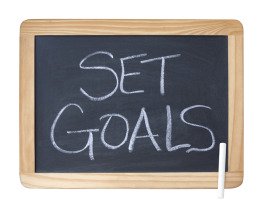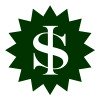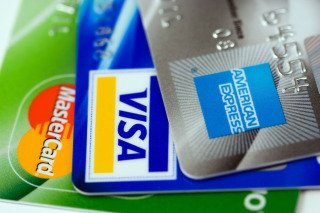8 personal finance goals
That Prepare You to Profit
 Personal finance goals are your starting point towards a better life; a wealthy life.
Personal finance goals are your starting point towards a better life; a wealthy life.
Without them, your current habits are your future habits. You've got no guide, no pathway to follow. They are the crucial first steps for achieving financial success!
Properly set goals improve your focus, channel your effort, and measure your progress (Follow this link to visit my page on focused goal setting.).
The following personal finance goals are the ones that I used to start my journey, and are still a good example today:
- Organize Your Finances
- Pay Yourself First
- Start an Emergency Fund
- Pay-off Debt with High Interest Rates
- Open a Retirement Account
- Pay-off Debt with Low Interest Rates
- Save a Down-Payment for a Home (if necessary)
- Begin Working on your own Safe Investing Strategies

Safe Investing Tip:
The first thing you'll discuss with a financial planner? Some version of these questions. Answering them ahead of time will put you in the driver's seat.
1) Get a Handle on Your Current Finances
The first personal finance goal requires that you do some legwork, but it will help you succeed in the end. This information is critical for the rest of the personal finance goals on this page.Take a minute to gather all your financial info from last month (savings and checking account statements, credit card statements, checkbook, paychecks, cable bills, phone bills, medical bills, etc., etc., etc.)
Hopefully that didn't take TOO long. Even if it did, you'll be well rewarded.
Now arrange the papers into three piles: Income (paychecks), Expenses (Bills), and Balances (Bank Statements). If you carry a balance on a credit card, put the statement in the "Balances" pile.
Not sure how to get going? Visit my page on organizing your personal finances. Here you'll find simple ways to think about the relationship between income, expenses, and "balances" (assets and liabilities).
With all your financial data in piles, the next step is to catalog all that data by creating your own personal financial statements.
The personal financial statements page can give you some additional background on financial statements, as well as links to our templates for Personal Income Statements and Personal Balance Sheets.
These forms provide the best overview of when and where you're spending your money. You'll see when you have extra cash (disposable income), and when you spend extra cash (i.e. holidays, birthdays, vacations, etc.).
At first glance, this may not seem like much of a personal finance goal; a lot of people just want to start investing. But stabilizing your financial situation is the very first step for any investing process.

Safe Investing Tip:
A personal financial statements sends a clear message to financial advisors; you're serious about your money and should be treated accordingly.
2) Pay Yourself First
 As the title implies, pay yourself before doing anything else with your money. After all, you're working hard for it. Give yourself a percentage (5-10%) of your gross (pre-tax) income each time you get a paycheck.
As the title implies, pay yourself before doing anything else with your money. After all, you're working hard for it. Give yourself a percentage (5-10%) of your gross (pre-tax) income each time you get a paycheck.
Technically, as an employee, there will be a lot of other deductions from your paycheck before you ever see it (pre-tax items like health insurance, retirement contributions, and taxes). But just because the timing is off, doesn't mean you can't have this as a mindset goal. And that's why I use gross income.
The easiest way to make sure that you pay yourself first is to make an automatic withdrawal from your checking account, using an online savings account. Since the transfers are electronic, it pays to shop around for the best interest rate. Many traditional brick-and-mortar banks offer online services, but online banks (and some credit unions) actually offer slightly higher interest rates.
Mint.com (a great personal finance site) provides an easy-to-use search tool for online savings accounts.
Click here to open a new window and search for an online savings account using Mint.com.
Another way you pay yourself first is by taking advantage of your company's retirement plan (401k, 403b, etc.). Make sure you contribute enough to get the "full match". By matching your contribution, your company is doubling your money...it is the closest thing you'll get to free money.
The "out of sight, out of mind" principle applies to your contributions, because you will adjust to your new level of spending. The contribution will also lower your total taxable income at the end of the year.
For more information on retirement investment accounts, click here.

Safe Investing Tip:
If you have to choose, start by contributing to your companies 401k plan. You'll double your money AND get a tax break.
3) Start an Emergency Fund
Creating an emergency fund is personal finance goal number 3. Saving a few months worth of expenses in a money market or savings account is not only a great idea; it can also give you security in times of uncertainty.Remember those personal financial statements you just created? Find your total, after-tax expenses for the last year. Divide that number by 12 and you'll have the average cash you'll need, per month, to cover expenses.
At first, this may only cover minimum payments to your credit cards, but that is ok.

Now, I'm sure you've heard a range of time periods for an emergency account; 1,3,6,9 months...even a year. But for people struggling to make ends meet, even 1 month can seem impossible.
So start smart (think SMART Goals)and start small.
Just because this is a "goal" does not mean that you can't break it into smaller pieces. Don't be afraid to make changes and adjust to your needs.
Start by making a personal finance goal to save 1 week's worth of expenses. Then go for 2 weeks. Now that you're rolling, try for 3 weeks and then 4. Before you know it, you'll have 1 month worth of expenses saved, and then there is no stopping you.
Go for two months, then 3. Then shoot for 6. With 6 down, go for 9.
Your emergency fund is an investment in peace of mind and will reduce the impact of losing a job or other source of income. I've lived through more than one round of downsizing and layoffs; the automotive industry is cyclical. Each time, I've see people experience huge stress levels because they've lived paycheck to paycheck and have no cushion to cover emergencies.
By hitting your goal, you'll have developed the habit of saving. And that 5-10% will begin to feel like "extra" money every month. Now that "extra" can go towards the next financial goal...like paying off your credit cards or funding an investing account.

Safe Investing Tip:
How many months does it take to find a job? Add 3 months to that number, and that is how long your emergency fund needs to last.
4) Pay Off Debt (High Interest Rates)
If you owe money (any kind of debt - credit card or otherwise), you're paying someone else for that money in the form of interest. In the world of safe investing, this is VERY risky, because you are not in control.Think of all debt as an investment that gives you a guaranteed loss every month. This will help prioritize your goals.
If you combine the power of compounding with high "negative" interest rates (see a both a positive and negative example of compound interest here), you can see why understanding and controlling debt it is so important to your financial future.

Paying off your debt is one of the most challenging personal finance goals, and it takes a lot of persistence.
There is a reason that homeowners throw "mortgage burning parties" after making their final payment!
But because your fully funded emergency account already covers these high interest payments (the minimum payment at the very least), you're in a strong position to achieve this personal finance goal.

Safe Investing Tip:
If you can't make more than 2-3% profit by investing, then paying off any debt with an interest rate higher than 3% is a better use of your money!
5) Open a Retirement Account
After getting rid of your high interest rate debt, the next personal finance goal is to open a retirement account. Time is on your side in a retirement account (since you shouldn't even think about touching this money until your in your mid-60s). So the earlier you start, the more you can take advantage of compounding. Your main priority is to open a Roth IRA. A Roth IRA is a special type of Individual Retirement Account (IRA). The benefit of this type of retirement investment account is related to tax structure.Simply put, your money will not be taxed when you make withdrawals properly during your retirement. Any profits that you make are tax free!
The downside is the contribution limit. You can only invest a few grand each year. In comparison, you can invest almost 3x as much in your 401k. This is the reason I say a Roth is your main priority; it will take more time to build up a nest-egg.
For more information on traditional and Roth IRA's, click here to open a new window for IRS Publication 590 - Individual Retirement Arrangements.
Most of you will also have the option of funding a retirement account through your employer. Long gone are the days of the pension, unless you work for the government. Instead, we have 401k's and/or traditional IRA's.
If your employer has a matching program (i.e. they match a certain percentage of the pre-tax money you contribute), contribute enough to get 100% of the match.
For example, if your employer matches 25% of every pre-tax dollar you invest up to 2%, then start contributing 2% immediately. That's an easy 25% return on your investment just for showing up.
After your getting the full match, check your monthly cashflows. Work on getting your expenses down enough to fully fund your Roth for the year.
If you still have money to burn after maxing out your Roth, start increasing your monthly 401k contributions again. You won't get a match, but you will be investing pre-tax dollars and lowering your end of the year tax bill.
6) Pay-off Debt (Low Interest Rates)
As mentioned above, debt is a guaranteed loss (expense) each month. Paying off low interest rate debt is important, but it has a smaller impact on your personal finances than higher interest rates.Examples of low interest rate debt usually include student loans, low interest rate balance transfers, or personal loans from family and friends.
7) Save a Down Payment for a Home (if needed)
First, if you're not in the market for a new home, you can replace this personal finance goal with another, high-dollar investment, such as a child's college tuition, a second retirement account, a wedding, etc. The goal is to decrease the amount of debt you'll need in the future.Purchasing a home is one of the largest financial commitments in personal finance. If you're in the market, the following questions can help you get started.
Start with the monthly payments that will start after you buy your home.
- What is the largest total monthly expense you can afford and still meet all your other goals (refer back to your personal financial statements)?
- What home-related expenses will affect your monthly cashflow:
- Property Taxes
- Insurance (PMI)
- Insurance (Home Owners and Vehicle)
- Natural Gas Bill
- Water Bill
- Electricity Bill
- Satellite/Cable/Phone Bills
- Vehicle Expenses (Maintenance/Gas due to changes in commute)
STOP!
Take your answers and figure out your maximum allowable mortgage payment.Subtract the total of all your new home's monthly expenses (use estimates if needed) from the maximum monthly expense you can sustain without compromising your goals.
Is the number negative? If yes, then don't buy a house. You need to have more income.
If you have money left over on a monthly basis, you can afford a home. But just just how much home you can afford?
- How much money do you have for a down payment?
- Private Mortgage Insurance (PMI) is required if your down payment is less than 20% of the purchase price, and will increase your monthly payments
Let's assume that you want to put 20% down and avoid PMI. Take the amount of money you have for a downpayment and divide it by 0.20. This will give you the amount of "home" you can afford.
For example, if I had $40,000 for a downpayment, I could afford a $200,000 home ($40,000/0.20=$200,000). That leaves me with a mortgage amount of $160,000.
- Bankrate.com has a straight-forward mortgage calculator that can help you determine monthly payments for a given loan amount.Click here to open a new window and visit the site.
STOP!
Add together all your new home's monthly expenses (use estimates if needed) AND your monthly mortgage payment. Now subtract that total from the maximum monthly expense you can sustain without compromising your goals.Is the number negative? If yes, then you need:
- Increase your downpayment to lower your mortgage amount and related monthly payments
- Find a home with a lower price
If you have money left over on a monthly basis, you can still afford a home...just one more hoop to jump through.
- Do you have enough cash to cover the closing costs?
- 6% of the mortgage amount can be used as a rough estimate for planning purposes
Using the $160,000 mortgage calculated above, I would need an additional $9,600 to be sure that I could cover the closing costs.
GO!

Safe Investing Tip:
As a rule of thumb, keep the total for all home/mortgage related expenses less than 30% of your monthly, after-tax income.
8) Start Investing Safely
Now you're well on your way to successfully creating and achieving some initial goals.These examples were just the beginning. Your personal finance goals will be just that...personal.
As you become more and more financially successful, you'll need to update, expand, or completely rewrite your personal finance goals.
And after you've left your financial advisor speechless, you'll be ready to start investing safely!
Click here to start researching the different ways of investing money.


